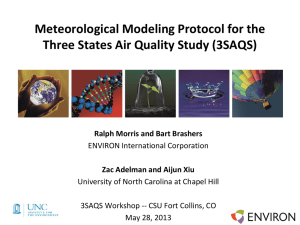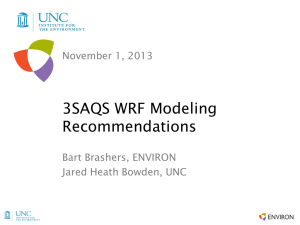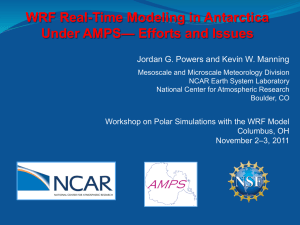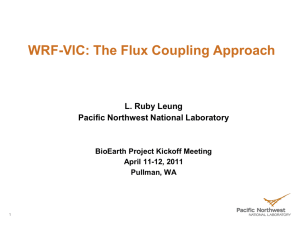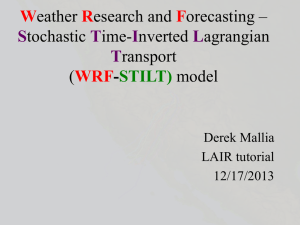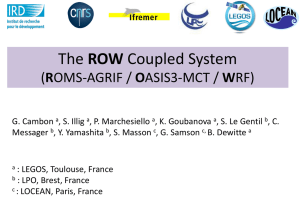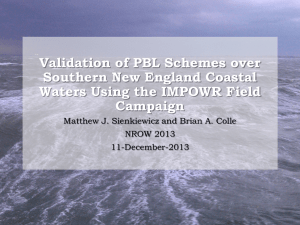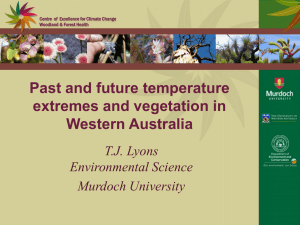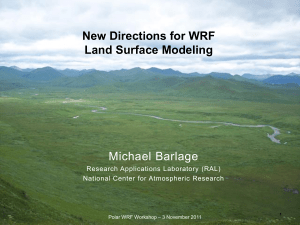3SAQS_TechCommMtg_2011_WRF_MPE_28July2014
advertisement
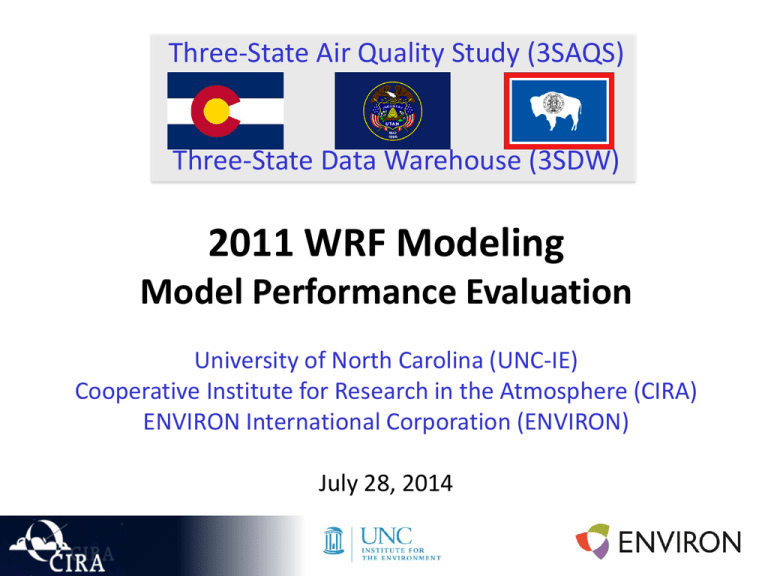
Three-State Air Quality Study (3SAQS) Three-State Data Warehouse (3SDW) 2011 WRF Modeling Model Performance Evaluation University of North Carolina (UNC-IE) Cooperative Institute for Research in the Atmosphere (CIRA) ENVIRON International Corporation (ENVIRON) July 28, 2014 3SAQS WRF MPE Summary • Objective: Develop best possible regional meteorology database for annual 2011 air quality modeling • Nested 36/12/4-km WRF-ARW 3.5.1 with configuration optimized for the intermountain West • Single configuration across the entire year – no special wintertime version at this time • Standard and extended model performance evaluation metrics focused on the 4 km three-state domain • MPE conclusion: 3SAQS 2011 WRF application exhibited reasonably good model performance that was as good or better than other recent prognostic model applications used in air quality planning 2 3SAQS Draft WRF 2011 MPE Report • Draft dated July 2014 Executive Summary 1.0 Introduction 2.0 Methodology 3.0 WRF Surface Model Performance Evaluation Results 4.0 Precipitation Evaluation 5.0 Evaluation for Winter High Ozone Periods 3SAQS Tech Committee Call June 19, 2014 • Summarized WRF surface and winter ozone model performance during June 19, 2014 3SAQS Technical Committee webinar • So will only highlight some of these results here with conclusions • In this presentation focus on new precipitation comparisons and overall conclusions 4 WRF Domain and Configuration • Standard (40N-97W) Lambert-Conformal Conic projection • CONUS 36km (165x129) • WestJumpAQMS 12km (256x253) • 3SAQS 4km (301x361) • 37 layers to 50 mb (12m surface layer) Configuration Tests • First-order simulations on all three domains for January 1-7 and July 1-7, 2011 to test different configurations: – NAM vs. ECMWF Initial and boundary conditions (ICBC) – 2006 NCLD vs. USGS land-use land cover (LULC) data – Noah-YSU vs. PX-ACM2 land surface/boundary layer schemes – Obs nudging coefficient and network sensitivities • Ultimately settled on the same configuration as WestJumpAQMS 2008 WRF 6 Evaluation Approach • AMET used to evaluate surface temperatures, winds, and mixing ratios against MADIS observations • Wintertime evaluation of winds, temperature, humidity and vertical temperature (inversions) • PRISM precipitation evaluations • Compared results to performance benchmarks (bias and error) for Western U.S. regional met modeling • Performance in CO, UT, WY, and 4-km 3S domain – average of all monitors within each area • Additional performance for snow cover, STE, planned in future 7 WRF Monthly Performance Summaries 2-m Temperature CO WY WRF Monthly Performance Summaries Wind Speed CO WY WRF Monthly Performance Summaries Wind Direction CO WY 10 WRF Monthly Performance Summaries Mixing Ratio CO WY Example Summary MPE Plot Jan Temperature in 4 km 3SAQS Domain Jul 12 2011 WRF MPE Surface Met • Almost always achieved Complex Performance Benchmark and Frequently achieved Simple Benchmarks • Performance as good or better than past WRF/MM5 applications in Rocky Mountains • No systematic bias or problem performance seen. • 3SAQS 4 and 12 km MPE products can be viewed at: http://views.cira.colostate.edu/tsdw/Tools/ImageBr owser.aspx?pathid=TsdwBase11aMetPlotsRoot 13 3SAQS 2011 WRF MPE Winter Ozone • 2011 WRF simulation included several high winter ozone events in Upper Green River Basin (URGRB) in southwest Wyoming during the Upper Green River Ozone Study (UGWOS) • 13 ozone exceedance days (76 ppb or higher) occurred during February and March 2011 – 123 ppb on Mar 2, 2011 – 121 ppb on Mar 3, 2011 – 121 ppb on Mar 12, 2011 14 UGRWOS Monitoring Sites 2011 Winter Ozone WRF Evaluation • Use UGWOS special study and routine NOAA ds3505 surface met obs in SWWY • Soccer plots for Feb and Mar and SWWY domain • Vertical temperature profiles • 3SAQS 2011 WRF run not configured for winter ozone conditions WRF Wind MPE UGRWOS & ds3505 Mar 1, 2011 1500 (Max O3 =121 ppb) Mar 2, 2011 1500 (Max O3 =123 ppb) Mar 10, 2011 1500 (Max O3 = 84 ppb) Mar 12, 2011 1500 (Max O3 = 121ppb) Winter Ozone WRF Conclusions • Need more focused evaluation for high ozone days • Some promise with low bias for winds and temperature – Large error not unexpected given slow wind speed • Vertical temperature matched reasonable well – Worse near the surface • 3SAQS 2011 WRF 36/12/4 km can provide starting point for focused higher resolution WRF model of winter ozone episodes using winter ozone WRF configuration in 3SAQS 2015 SOW 24 Precipitation Evaluation Approach • Monthly total precipitation from PRISM analysis fields – Parameter-elevation Regressions on Independent Slopes Model – Interpolates precipitation observations using regression equations to account for elevation and other factors – Regrid ~1 km PRISM data to WRF domains – Note: PRISM analyses fields only for lower 48 USA • Canada, Mexico and Oceans not included • Qualitative comparison of monthly WRF and PRISM precipitation – PRISM also has daily products – Plans to develop quantitative PRISM evaluation tool in future 25 January Monthly Precipitation (inches) PRISM WRF 26 March Monthly Precipitation (inches) PRISM WRF 27 May Monthly Precipitation (inches) PRISM WRF 28 July Monthly Precipitation (inches) PRISM WRF 29 August Monthly Precipitation (inches) PRISM WRF 30 September Monthly Precipitation (in) PRISM WRF 31 October Monthly Precipitation (in) PRISM WRF 32 December Monthly Precipitation (in) PRISM WRF 33 3SAQS 2011 WRF Precipitation MPE • Very good agreement between PRISM and WRF monthly precipitation spatial fields and magnitudes during winter and adjacent months – WRF able to simulate synoptic storm systems well • PRISM/WRF agreement during monthly total precipitation in summer months not as good – Convective precipitation has been historically difficult for WRF/MM5 to simulate – Questions whether PRISM interpolation scheme appropriate for summer thunderstorms 34 3SAQS 2011 WRF Conclusions • WRF surface meteorological performance consistent achieves model performance benchmark across CO, UT and WUY and 4 km domain – Some indication model has difficulty simulating nocturnal inversions in complex terrain – Appears to be a slow wind speed bias of ~-0.5 m/s year-round – Mixing ratio overestimated in cooler and underestimated in warmer months • Monthly precipitation performance in winter and adjacent months quite good – Maybe some issues with summer convective precipitation • Overall, 3SAQS 2011 WRF performance was reasonably good and as good or better than the performance of other WRF/MM5 applications in the Rocky Mountain region 35 3SAQS 2011 WRF Next Steps • Update draft 3SAQS 2011 WRF MPE report – Over next week or two • Focused high-resolution WRF sensitivity modeling for winter ozone events (2015 SOW) – Leverage work of University of Utah and others – Snow cover and cloud evaluation • In addition to surface, upper-air and precipitation • Stratospheric/Tropospheric Exchange (STE) – Need PGM modeling results to evaluate WRF 36

